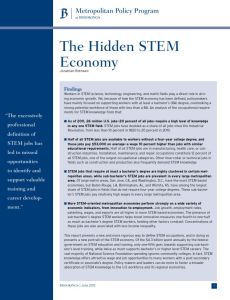加入 getAbstract 阅读摘要

加入 getAbstract 阅读摘要
Jonathan Rothwell
The Hidden STEM Economy
Brookings Institution Press, 2013
看看什么内容?
The “hidden STEM economy” isn’t flashy or powerful, but it does pave the way for job creation and economic growth.
Recommendation
The highest paying science, technology, engineering and math (STEM) jobs often require an undergraduate degree. But another segment of STEM jobs, such as those for computer technicians and skilled construction personnel, don’t require four years of university, and they pay much more than jobs with comparable education requirements. This Brookings Institution paper zeroes in on the importance of the often-overlooked nondegree STEM careers that contribute significantly to economic growth and innovation. getAbstract recommends this incisive report to executives, educators and policy makers charged with promoting educational and training opportunities in these areas.
Summary
About the Author
Jonathan Rothwell is an associate fellow at the Metropolitan Policy Program at Brookings.




















Comment on this summary